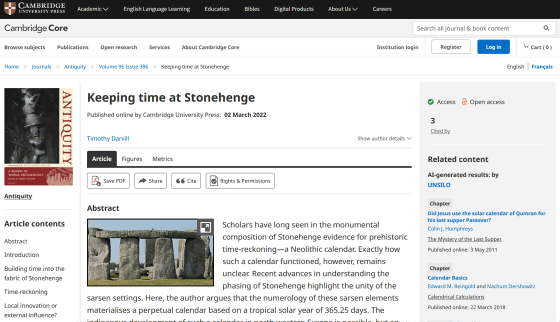Objection that the theory that 'Stonehenge is a calendar of the solar calendar' just forcibly forced the numbers

Archaeoastronomy and the alleged 'Stonehenge calendar' | Antiquity | Cambridge Core
https://doi.org/10.15184/aqy.2023.33
The 'Stonehenge calendar' shown to be a modern construct
https://phys.org/news/2023-03-stonehenge-calendar-shown-modern.html
Nope, Stonehenge Isn't an Ancient Calendar After All, Scientists Say : ScienceAlert
https://www.sciencealert.com/nope-stonehenge-isnt-an-ancient-calendar-after-all-scientists-say
Stonehenge, located about 13km northwest of Salisbury, is a structure in which huge sandstones called sarsenite are arranged in a circular shape. increase.
On the day of the summer solstice, the sun rises over the Heel Stone, a 6m high basalt rock northeast of Stonehenge, and its rays shine straight into the center of Stonehenge. In this regard, it has long been thought that the builders of Stonehenge may have had astronomical knowledge.
In 2022, Tim Darvill, an archaeologist at Bournemouth University, published a paper claiming that ``Stonehenge is a calendar showing a solar calendar with 365 days in a year.''
Keeping time at Stonehenge | Antiquity | Cambridge Core
https://doi.org/10.15184/aqy.2022.5

According to Mr. Darvill, there are a total of 30 stones in the outer ring that makes up Stonehenge, and one corresponds to 'one day'. Adding 12 times 360 and 5, which is the number of trilithons arranged in the gate shape, gives 365 days, which is the number of days in a year. In addition, four stones called 'station stones' placed on the four sides of Stonehenge correspond to the leap day that must be added every four years.
These figures show that Stonehenge was built as a solar calendar, and Darvill argues that Stonehenge's builders modified the solar calendar used in Egypt by adding leap days. .
In response to Darvill's assertion, Giulio Magli, a mathematician at the Politecnico di Milano, and Juan Antonio Belmonte, an astronomer at the Canary Institute of Astrophysics, said, ``Darvill's theory is a series of unreasonable interpretations, published a paper arguing that it was based on esotericism, unsupported similarities to other cultures.
According to Magli et al., it is possible to find various 'numbers' in archaeological sites, and it is not difficult to link the number of Stonehenge stones to the solar calendar. In addition, the source of the number ``12'' multiplied by the number ``30'' of the stones that make up the outer ring is unknown, and points out that various numbers are ignored when looking at the entire ruins.
Even without the fine numbers, Stonehenge's structure isn't precise enough to distinguish subtle daily movements of the sun. Especially around the summer solstice, the sun on the horizon moves slowly, so it seems difficult to guess that Stonehenge, which is made up of megaliths, is a calendar showing 365 days.
Furthermore, the theory that Stonehenge's builders improved the Egyptian calendar and devised a solar calendar that added leap years is just wild speculation. In fact, the Egyptians did not build structures that could distinguish days with great precision, and the idea of adding leap days to correct for solar calendar discrepancies dates back about 2,000 years to the construction of Stonehenge. It is said that it was first documented later. Without prejudice, the builders of Stonehenge, like other Neolithic cultures, likely used the lunar calendar.
Magli et al. argued that 'Stonehenge is clearly not such a device (solar calendar).'

Related Posts:
in Note, Posted by log1h_ik







